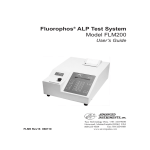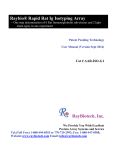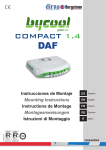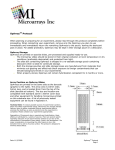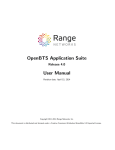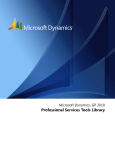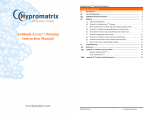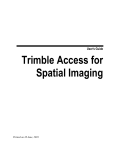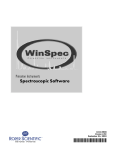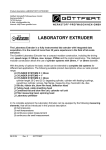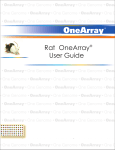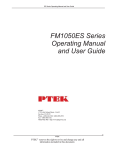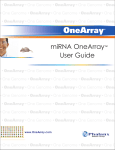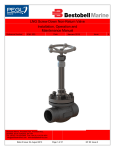Download Antibody Array User`s Guide
Transcript
Antibody Array User’s Guide Full Moon BioSystems, Inc. Antibody Microarray User’s Guide Rev. 11.3 Page 1 Antibody Array User’s Guide Full Moon BioSystems, Inc. TABLE OF CONTENTS Introduction.................................................................................................................................................... 3 Antibody Arrays ............................................................................................................................................. 3 Antibody Array Assay Kit ............................................................................................................................... 3 How It Works ................................................................................................................................................. 4 Experimental considerations ......................................................................................................................... 4 Components .................................................................................................................................................. 5 Additional Materials Required ....................................................................................................................... 7 Reagent Preparation ..................................................................................................................................... 8 Protocol ......................................................................................................................................................... 9 Array Scanner Recommendations .............................................................................................................. 16 Rev. 11.3 Page 2 Antibody Array User’s Guide Full Moon BioSystems, Inc. INTRODUCTION Antibody Microarray is a high-throughput ELISA based platform for efficient protein expression profiling, screening, and comparison between normal, diseased, or treated samples. Full Moon BioSystems’ antibody arrays allow researchers to detect and analyze hundreds of native proteins simultaneously on a single slide, saving precious resources and reducing the number of variables that affect experimental outcome. Our unique collection of antibody arrays includes phospho-specific arrays for studying phosphorylation events, comprehensive exploratory arrays for examining hundreds of proteins in a single experiment, and pathway arrays for studying highly relevant proteins in specific research fields. Suitable samples include cell lysates, fresh/froze/FFPE tissue lysates, serum, culture supernatant and bodily fluids. ANTIBODY ARRAYS The antibodies are covalently immobilized on a high quality glass surface coated with our proprietary 3D polymer materials to ensure high binding efficiency and specificity. All arrays are printed on standardsize microscope slides, and each slide contains one complete array. The arrays utilize fluorescent detection and can be scanned on all microarray scanners that are compatible with 76 x 25 x 1 mm (3 inch x 1 inch x 1 mm) slides. To maximize data reliability, each antibody on the array is printed with replicates. Pathway arrays contain six replicates. Explorer Antibody Array, Phospho Explorer Array, and Signaling Explorer Array contain two replicates for each antibody. To see a list of the antibodies featured in a specific array and their reactivity information, please visit our website, www.fullmoonbio.com and select the array of your choice. Go to the Documentation section to view Antibody List and Array Layout. Multiple positive markers and negative controls are included in each array. Positive markers contain Cy3 labeled antibodies to mark the boundaries of the array. Negative controls contain BSA. Empty spots contain nothing, and their signal intensity can be used as background in data analysis. Each set of antibody arrays contains two slides (two identical arrays) – one slide can be used for a control sample, and the other for a treated sample. GAL files are provided for each array and can be downloaded from www.fullmoonbio.com/support/gal/. ANTIBODY ARRAY ASSAY KIT The Antibody Array Assay Kit is designed for easy and reliable processing of Full Moon BioSystems’ antibody arrays. It provides the major reagents required to perform protein extraction, labeling, conjugation and detection. The reagents are convenient, easy to use, and optimized to work with our antibody arrays. Each kit provides sufficient reagents to perform assays on two slides. Rev. 11.3 Page 3 Antibody Array User’s Guide Full Moon BioSystems, Inc. HOW IT WORKS Protein Extraction from cells, tissues, or bodily fluids Biotinylation of Proteins Protein Conjugation to Antibody Array Detection by Dye-Streptavidin Y Y Y Y Y Y Y Y Y Y The ELISA based antibody array platform involves four major steps: 1) Protein extraction with nondenaturing lysis buffer; 2) Biotinalyte the protein samples; 3) Couple the labeled samples to the antibodies on the array; and 4) Detection by dye conjugated streptavidin. Proteins used in the assay are not denatured, and their native tertiary structures are intact. This may increase the chance for false negatives due to inaccessible binding residues on the protein. Rev. 11.3 Page 4 Antibody Array User’s Guide Full Moon BioSystems, Inc. EXPERIMENTAL CONSIDERATIONS All reagents and materials are intended for research use only. Handle the slides by holding the area with barcode labels. Do not touch the slide surface. Use extra care; Any variation in buffers, operator, pipetting technique, washing technique, and incubation time or temperature can alter the performance of the kit. Only use reagents and materials recommended by this user’s guide. Do not substitute buffers or solutions from other sources. Do not allow arrays dry out between blocking, coupling, and washing. It can cause high background. Wash the arrays extensively with Wash Solution and water to remove excess residual reagents from the slide surface. The reagents provided in the Antibody Array Assay Kit do not contain protease inhibitors. To prevent protein degradation, you should work quickly and proceed diligently towards the array analysis step once you start the extraction. Alternatively, you may use inhibitors if you prefer or plan to store the proteins for a week or longer. Always wear gloves before handling any reagents. COMPONENTS Antibody Arrays Material/Reagent Quantity Purpose Storage Condition 2 slides Microarray 4°C (6 months) Gal File 1 Data Analysis Online download User’s Guide 1 Instructions Online download Antibody Microarray Rev. 11.3 Page 5 Antibody Array User’s Guide Full Moon BioSystems, Inc. Antibody Array Assay Kit (sold separately from the arrays) Catalog No. Description Quantity KAS02 Antibody Array Assay Kit, 2 Reactions 2 Reactions KAS20 Antibody Array Assay Kit, 20 Reactions 20 Reactions Quantity Material/Reagent Purpose Storage Condition 2-Rxn Kit 20-Rxn Kit Biotin Reagent 1 mg 5 x 1mg Labeling -20 °C Blocking Reagent 60 mL 600 mL Blocking 4 °C Coupling Chamber 1 5 Coupling RT Coupling Reagent 12 mL 120 mL Coupling -20 °C Detection Buffer 60 mL 600 mL Detection 4 °C DMF 200 uL 1 mL Labeling 4 °C 1.8g & 0.36g 18g & 3.6g Coupling 4 °C 1.5 mL 15 mL Cell and tissue lysis 4 °C 2 mL 20 mL Labeling 4 °C 2 tubes 20 tubes Cell and tissue lysis RT or 4 °C Spin Columns 2 sets 20 sets Buffer Exchange RT Stop Reagent 100 uL 1 mL Stop labeling reaction 4 °C 10X Wash Buffer 100 mL 500 mL x 2 Washing 4 °C Dry Milk Extraction Buffer Labeling Buffer Lysis Beads Rev. 11.3 Page 6 Antibody Array User’s Guide Full Moon BioSystems, Inc. ADDITIONAL MATERIALS REQUIRED 1X PBS, pH=7.4 Dye conjugated streptavidin o Cy3-Streptavidin is commonly used. It can be purchased from any vendors including GE Healthcare: PA43001; Invitrogen: S-32355 (Alexa Fluor 555 streptavidin); Sigma-Aldrich: S6402, and others. o Other dye labeled streptavidin can be used in place of Cy3-streptavidin as long as the dye is compatible with your array scanner. 50 mL conical tube with cap Centrifuge with 1.5 mL microtube rotor Milli-Q Grade Water or dd H2O Orbital shaker Petri dishes, 100 x 15mm (9 cm in diameter) Slide drying (only one option is required) o By compressed air: compressed nitrogen/clean air supplied by a central line or from a cylinder. Do not use canned air duster or heat gun/blower. o By centrifugation: centrifuge with 50 mL swinging bucket rotor UV Spectrophotometer Vortexer Microarray scanner compatible with 3 x 1 inch (76 x 25 mm) slides -- Optional o Rev. 11.3 If you don’t have access to a scanner, you can send the finished array slides to our lab for scanning. Please visit our website for details. Page 7 Antibody Array User’s Guide Full Moon BioSystems, Inc. REAGENT PREPARATION REAGENTS TO WARM BEFORE USE Blocking Reagent Coupling Reagent Wash Buffer Warm to 25-30°C in a water bath. Biotin Detection Buffer DMF Dry Milk Labeling Buffer Stop Reagent Warm to room temperature. 2-RXN Kit (KAS02) 1 1X Wash Solution Make 1:10 dilution. In a one-liter reagent bottle, add 100 ml of 10X Wash Buffer to 900 ml of dd H2O. Shake to mix. 2 Blocking Solution Add 1.8 g of Dry Milk to 60 ml of Blocking Reagent. Shake to mix. Be sure the milk powder is completely dissolved. Use within one week. 3 Coupling Solution Add 0.36 g of Dry Milk to 12 ml of Coupling Reagent. Shake to mix. Be sure the milk powder is completely dissolved. Use within one week. 20-RXN Kit (KAS20) 1 1X Wash Solution Make 1:10 dilution. For example, add 100 ml of 10X Wash Buffer to 900 ml of ddH2O to make 1L of 1X Wash Solution. Shake to mix. 2 Blocking Solution If you plan to perform 20 assays within one week, add 18 g of Dry Milk to 600 ml of Blocking Reagent. Be sure the milk powder is completely dissolved. For two assays, aliquot 60 ml of Blocking Reagent and add 1.8 g of Dry Milk. Shake to mix. Use within one week. 3 Coupling Solution If you plan to perform 20 assays within one week, add 3.6 g of Dry Milk to 120 ml of Coupling Reagent. Be sure the milk powder is completely dissolved. For two assays, aliquot 12 ml of Coupling Reagent and add 0.36 g of Dry Milk. Shake to mix. Use within one week. Rev. 11.3 Page 8 Antibody Array User’s Guide Full Moon BioSystems, Inc. PROTOCOL – DETECTION BY CY3-STREPTAVIDIN IMPORTANT – WARM REAGENTS BEFORE USE (See Reagent Preparation for detailed instructions) A. Protein Extraction Note: It is recommended that protein extraction is performed with the Extraction Buffer provided in the Antibody Array Assay Kit (KAS02). Other protein extraction procedures or lysis buffers can be used. However, high concentrations of certain compounds adversely affect biotinylation of protein samples. Be sure the lysis buffer contains no more than 50mM Tris, 0.1% SDS, 1% Triton X-100, or 1% NP-40. Please feel free to contact us if you are unsure about your lysis buffer. Note: The reagents provided in the Antibody Array Assay Kit do not contain protease or phosphotase inhibitors. Commonly used protease and/or phosphatase inhibitors (such as Roche’s inhibitor cocktail) may be added to Extraction Buffer to prevent protein degradation or dephosphorylation. I. Cells 1. Adherent Cells: Remove media and wash the culture with ice cold 1X PBS 3 – 5 times. Remove remaining PBS and add 100 – 200 uL of Lysis Buffer to 1 to 5 million cells. Detach cells using a scraper and transfer the cells and remaining supernatant to a clean microcentrifuge tube. Add one tube of Lysis Beads. Suspension Cells: Transfer media containing cells to a clean tube. Pellet the cells by centrifugation at 500 x g for 2 minutes at 4°C. Remove media completely without disrupting the cells. Wash the pellet with ice cold 1X PBS followed by centrifugation. Repeat three times to ensure complete removal of media. Discard supernatant. Add Extraction Buffer and one tube of Lysis Beads to the cells. The amount of Extraction Buffer needed should be determined by the number of cells harvested. For 1 – 5 million cells, use 100 - 200 uL of Extraction Buffer. Important: Only use PBS to wash cells. To protect protein activity, avoid using trypsin or other reagents. 2. Vortex rigorously for 30 seconds to 1 minute. Incubate on ice for 10 minutes. Repeat five times. 3. Centrifuge the mixture at 10,000 x g for 5 minutes at 4°C. 4. Transfer all liquid to a clean tube. Discard the beads. 5. Centrifuge the new tube with liquid at 18,000 x g for 15 – 20 minutes at 4°C. 6. The supernatant on top should look colorless and transparent as water. Transfer the clear supernatant to a clean tube. Important: If the supernatant appears to be cloudy, centrifuge again at 18,000 x g for 15 to 20 minutes at 4°C. Check again. If the supernatant is still not clear, store the lysate at - Rev. 11.3 Page 9 Antibody Array User’s Guide Full Moon BioSystems, Inc. 70°C for 10 to 20 minutes. Immediately centrifuge at 18,000 x g for 15 to 20 minutes at 4°C after removal from freezer. Save the top clear layer and discard the rest. The supernatant should look colorless and transparent as water. 7. Proceed immediately to Step B (Buffer Exchange/Lysate Purification). II. Tissues 1. Wash tissues with ice cold 1X PBS with vortexing. Remove and discard PBS. Repeat 3 – 5 times. Important: If blood in the tissues gets in the lysate, it will lead to high background on the arrays. Be sure to remove blood from the tissues completely. Increase the number of PBS washes if necessary. When blood has been completely removed, the tissues should appear white, and the PBS wash solution should appear clear and colorless. 2. Add one tube of Lysis Beads to 10 – 40 mg of tissues. 3. Add Extraction Buffer to the tissues. The amount of Extraction Buffer needed should be determined by the amount of tissue harvested. For 10 – 20 mg of tissue, use 100 uL of Extraction Buffer; for 20 – 40 mg of tissue, use 200 uL of Extraction Buffer. 4. Vortex rigorously for 30 seconds to 1 minute. Incubate on ice for 10 minutes. Repeat five times. 5. Centrifuge the mixture at 10,000 x g for 5 minutes at 4°C. 6. Transfer all liquid to a clean tube. Discard the beads. 7. Centrifuge the new tube with liquid at 18,000 x g for 15-20 minutes at 4°C. 8. The supernatant on top should look colorless and transparent as water. Transfer the clear supernatant to a clean tube. Important: If the supernatant appears to be cloudy, centrifuge again at 18,000 x g for 15 to 20 minutes at 4°C. Check again. If the supernatant is still not clear, store the lysate at 70°C for 10 to 20 minutes. Immediately centrifuge at 18,000 x g for 15 to 20 minutes at 4°C after removal from freezer. Save the top clear layer and discard the rest. The supernatant should look colorless and transparent as water. 9. Proceed immediately to Step B (Buffer Exchange/Lysate Purification). III. Serum/Plasma 1. Centrifuge the serum/plasma sample at 18,000 x g for 10 – 15 minutes at 4°C. 2. Transfer 2 – 3 uL of the clear, pale yellow liquid to a new tube and proceed directly to Step D (Protein Labeling). Important: After centrifugation, a thin milky film often collects at the top. When removing the sample for labeling, it is important that the milky film is not transferred to the new tube. Make sure that the pipette tip pierces through the milky film, then release the pipette to aspirate the clear, yellowish serum/plasma. It’s helpful to wipe off the pipette tip with a Kimwipe before releasing the sample in the new tube. B. Buffer Exchange/Lysate Purification Rev. 11.3 Page 10 Antibody Array User’s Guide Full Moon BioSystems, Inc. Important: This step ensures the removal of unwanted buffer from your protein extract and replaces it with the Labeling Buffer provided in the Antibody Array Assay Kit. 1. The sample volume capacity of each spin column is 100 uL. 2. Gently tap the columns to ensure that the dry gel has settled to the bottom of the column. Remove the top column cap and reconstitute the column by adding 650 uL of Labeling Buffer. 3. Replace the column cap and vortex vigorously for about 5 seconds. Remove air bubbles by sharply tapping the bottom of the column. Allow at least 30 to 60 minutes of room temperature hydration time before using the column. Note: If the column was stored at 4°C, allow the column to reach to room temperature before use. 4. After hydration, remove the top column cap and then remove the column end stoppers from the bottom. 5. Spin the column in its wash tube at 750 x g for two minutes to remove excess fluid. 6. Blot excess drops from the bottom of the column. Discard the wash tubes and the excess fluid. Do not allow the gel material to dry excessively. Process the samples within the next few minutes. 7. Transfer up to 100uL of protein extract by carefully dispensing the sample directly onto the center of the gel bed at the top of the column without disturbing the gel surface. Do not touch the sides of the columns with the reaction mixture or the sample pipet tip since this can reduce the purification efficiency. 8. Place the column into a collection tube and place both together into the rotor. Maintain proper column orientation. 9. Spin the column and collection tube at the 750 x g for 2 minutes. 10. The purified protein will collect at the bottom of the collection tube. Discard the spin column. 11. Proceed immediately to the next step. C. Lysate quantification and QC 1. Lysate quantification: Measure lysate sample’s protein concentration by UV absorbance spectroscopy (A280), BCA assay, Bradford assay, or other quantification methods. UV Absorbance A280: Measure protein sample’s absorbance (OD). Use Labeling Buffer or water as blank. Note: The minimum absorbance is 3 OD. If the OD for your sample is too low, the sample must be concentrated at 4°C in a vacuum centrifuge, such as SpeedVac, or using YM-10 filters (Millipore Corporation). Note: Only absorbance (OD) reading is required. This reading will be used in later steps to determine the amount of sample used for labeling and coupling. Conversion to protein concentration (mg/ml) is not necessary. Most A280 assays assume 1 OD = 1 mg/ml. This Rev. 11.3 Page 11 Antibody Array User’s Guide Full Moon BioSystems, Inc. conversion is not accurate for lysate samples because the non-protein components (such as, nucleic acids, insoluble lysate factors) absorb UV light and interfere with the assay. BCA and Bradford assays: either assay can be used to determine lysate sample’s protein concentration. The minimum protein concentration required is 2 mg/ml. 2. Lysate Quality Control by A280 Assay – Optional, but highly recommended. This step can be performed at the same as Step 1 above. The quality of lysate sample directly affect assay results. The lysate sample should be as clear and transparent as water. Cloudy or unclear lysate sample will result in low labeling efficiency and high background. A280 spectrum is a good way to determine whether the lysate sample has sufficient clarity. Clear lysate produces two well separated peaks at 200-230nm and 240-280nm. If the peaks are not well separated, it indicates the lysate is not clear enough. To improve the lysate’s quality, store the lysate at -70°C for 10 to 20 minutes. Remove from the freezer and immediately centrifuge at 18,000 x g for 15 to 20 minutes at 4°C. Save the top clear layer and discard the rest. This is a UV absorbance spectrum of a clear cell lysate. One peak is observed at 230nm, and a second peak is observed at 270nm. The two peaks are clearly separated. This shows that the lysate is clear and ready for the next step. 3. Proceed immediately to the next step (Protein Labeling) or store the lysate at -80°C. Rev. 11.3 Page 12 Antibody Array User’s Guide Full Moon BioSystems, Inc. D. Protein Labeling – Biotinylation of Protein Samples 1. Biotin Preparation a. Briefly centrifuge Biotin Reagent before use. b. Add 100 ul of DMF (N,N-Dimethylformamide) to 1 mg of Biotin Reagent. It will give a concentration of 10 ug/ul. Mix by vortexing, then quickly spin it down. Label this solution as Biotin/DMF. 2. Labeling a. Aliquot 10 – 25 ul of lysate. It should contain 80 – 150 OD of protein. (If BCA or Bradford assay was used to measure protein concentration, the aliquot should contain 30 – 100 ug of protein.) When working with serum, aliquot 3 – 4 ul of serum. b. Add Labeling Buffer to the sample to bring the volume to 75 ul. c. Add 3 ul of the Biotin/DMF solution to the sample. Incubate the mixture at room temperature for 1 – 2 hours with vortexing every 10 minutes. Note: Store the rest of the Biotin/DMF solution at -20°C for future use. d. Add 35 ul of Stop Reagent. Mix by vortexing, then quickly spin down. Incubate for 30 minutes at room temperature with mixing. e. Proceed immediately to the next step, or store the biotinylated sample at -80°C for future use. E. Blocking Pre-blocking preparation: Remove the Antibody Array pack from refrigeration. Before opening the package, allow the slides to warm up to room temperature (30 to 60 minutes). Then open the package and allow the slides to dry for 30 or more minutes. Depending on the ambient temperature and humidity, adjust warm-up and drying time accordingly. 1. Add 30 ml of Blocking Solution (See “Reagent Preparation”) in a 100 x 15 mm Petri dish. Important: Make sure the solution is at room temperature and that the dry milk is completely dissolved before use. 2. Submerge one slide in the Blocking Solution. The side with a barcode label must face up. 3. Incubate on an orbital shaker rotating at 55 rpm for 30 to 45 minutes at room temperature. 4. Rinse the slide extensively with Milli-Q grade water as follows: 1. Place the slide in a 50-ml conical tube. Fill the tube with 45 ml of water. Close the cap. Shake for 10 seconds. Discard the water. 2. Repeat ten times. Important: It is critical to rinse the slide extensively to completely remove Blocking Solution from the slide surface. A clean slide will ensure a uniform and low background. Because antibodies are covalently immobilized on the slide surface, rigorously washing will not strip them off. After the last rinse cycle, the thin layer of water left on the slide surface should appear uniformly smooth across the entire surface. If it looks spotty, it means the surface is not clean. Please repeat Step 4. 5. Shake off excessive water on the slide surface. Proceed immediately to the next step. Rev. 11.3 Page 13 Antibody Array User’s Guide Full Moon BioSystems, Inc. Note: Do not allow the slide to dry out. If you are not ready to start coupling, place the slide back in the conical tube filled with clean water. F. Coupling Note: You should prepare the Protein Coupling Mix (Step F.1) in advance so that you can start coupling immediately after blocking. 1. In a tube, add 6 ml of Coupling Solution (See “Reagent Preparation”) and one tube of biotinylated sample (80 – 150 OD or 30 – 80 ug). Vortex briefly to mix. Label it as “Protein Coupling Mix.” Important: Make sure Coupling Solution is at room temperature and that the dry milk is completely dissolved before use. 2. Place the slide in Well 1 (or any clean well) of the Coupling Chamber. 3. Slowly pour all 6 ml of Protein Coupling Mix over the slide. Make sure the slide is completely submerged. Cover the Coupling Chamber. 4. Incubate on an orbital shaker rotating at 35 rpm for 1 – 2 hours at room temperature. 5. Transfer the slide to a 100x15 mm Petri dish containing 30 ml of 1X Wash Solution (See “Reagent Preparation”). Increase shaker’s speed to 55 rpm, continue for 10 minutes at room temperature. 6. Discard the wash solution. Repeat the wash step twice. 7. Rinse the slide extensively with Milli-Q grade water as follows: 1. Place the slide in a 50-ml conical tube. Fill the tube with 45 ml of water. Close the cap. Shake for 10 seconds. Discard the water. 2. Repeat ten times. Important: It is critical to rinse the slide extensively to completely remove Coupling Solution from the slide surface. After the last rinse cycle, the layer of water left on the slide surface should appear uniformly smooth across the entire surface. If it looks spotty, it means the surface is not clean. Please repeat Step 7. 8. Shake off excessive water on the slide surface and proceed to the next step immediately. Note: Do not allow the slide to dry out. G. Detection 1. Add 60 ul of Cy3-streptavidin (0.5 mg/ml) to 60 ml of Detection Buffer. 2. Pour 30 ml of Cy3-streptavidin Solution into a 100x15 mm Petri dish. 3. Submerge the slide in the Cy3-streptavidin solution. Incubate on an orbital shaker rotating at 35 rpm for 20 minutes at room temperature in the dark or covered with aluminum foil. 4. Transfer the slide to a new 100x15 mm Petri dish containing 30 ml of 1X Wash Solution. Increase shaker’s speed to 55 rpm, continue for 10 minutes at room temperature. 5. Discard the wash solution. Repeat the wash step twice. 6. Rinse the slide extensively with Milli-Q grade water as follows: Place the slide in a 50-ml conical tube. Fill the tube with 45 ml of water. Close the cap. Shake for 10 seconds. Rev. 11.3 Page 14 Antibody Array User’s Guide Full Moon BioSystems, Inc. Discard the water. Repeat ten times. Important: It is critical to rinse the slide extensively to completely remove Detection Solution from the slide surface. After the last rinse cycle, the layer of water left on the slide surface should appear uniformly smooth across the entire surface. If it looks spotty, it means the surface is not clean. Please repeat Step 6. 7. Hold the slide with your fingers, shake off excess water from the slide. 8. Dry the slide with compressed nitrogen (or air) or by centrifugation. Note: The goal is to remove water from the slide as quickly as possible. By compressed air: Do not use compressed air in a can (for example, desktop air duster). Compressed air or nitrogen from a cylinder tank or an outlet on the fume hood is adequate. Make sure the pressure is less than 40 psi. Point the air nozzle at a 30° angle, one inch away from the slide surface. Starting from one end of the slide, push the water off of the surface. Repeat for the back side of the slide. By centrifugation: place the slide in a 50-ml conical tube, and close the cap. Centrifuge the tube at 1300 x g for 5 – 10 minutes. 9. The slide is now ready for scanning. Note: If you do not have access to a microarray scanner, you can send the slides to our lab for scanning. Please visit our website for details. To prepare the slides for shipping, place the slides back in the slide holder. Cover the slide holder with aluminum foil to protect the slides from light. Send the package at room temperature. Please include the array information and your contact information (name, organization, phone and email address) in the package. Shipping address: Attn: Array Scanning Service Full Moon BioSystems, Inc. 754 North Pastoria Avenue Sunnyvale, CA 94085 United States Rev. 11.3 Phone: 408-737-1702 Email: [email protected] Page 15 Antibody Array User’s Guide Full Moon BioSystems, Inc. ARRAY SCANNING AND IMAGE ANALYSIS All scanners that are compatible with 75mm x 25mm (3in x 1in) microscope slides can be used to scan Full Moon BioSystems’ antibody arrays. Recommended Scanning Resolution: 20um or higher (10um, 5um, etc.) Compatible Systems Manufacturer Product Name Agilent Technologies SureScan Microarray Scanner All models Alpha Innotech AlphaScan™ Microarray Scanner NovaRay™ Detection Platform Applied Precision arrayWoRx®e Biochip Reader Aurora Photonics PortArray 5000™ Biomedical Photometrics The DNAscope™ HR Bio-Rad VersArray ChipReader™ GE Healthcare, formerly Amersham Biosciences Typhoon™ 9410, 9210, 8610 Genewave AmpliReader™ 4600 Microarray Reader InDevr Vidia™ Microarray Imaging System INNOPSYS InnoScan® Microarray Scanner 700, 900, Autoloader Molecular Devices, formerly Axon Instruments PerkinsElmer, formerly Packard Bioscience GenePix® Microarray Scanner All models ProScanArray® HT Microarray Scanner ProScanArray® Microarray Scanner ScanArray® GX Microarray Scanner ScanArray® GX PLUS Microarray Scanner Tecan LS Reloaded™ Versatile Scanner PowerScanner™ Microarray scanner Revolution™ 4200 Microarray Scanner Vidar Systems Required Accessory Microarray Slide Holder Kit Image Analysis Array images can be analyzed by any image quantification software including analysis software provided by scanner manufacturers, third-party software, or open source programs (such as, ImageJ). Rev. 11.3 Page 16 Antibody Array User’s Guide Full Moon BioSystems, Inc. A GAL (GenePix Array List) file for each array is provided to aid image analysis. Please note GAL files may not be compatible with a number of systems named above. If your image analysis does not work can be downloaded from our website. GAL files describe the size and position of blocks, the layout of featureindicators in them, and the names and identifiers of the printed substances associated with each feature-indicator. automatically generate grids for image analysis. Rev. 11.3 Page 17

















